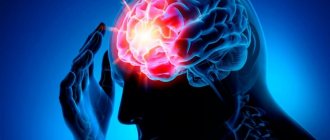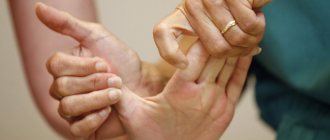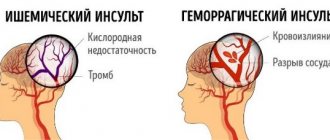Anesthesiologist-resuscitator
Smirnov
Igor Valerievich
18 years of experience
Leading anesthesiologist-resuscitator of the highest category, member of the European Society of Anaesthesiology
Make an appointment
Coma is a life-threatening pathology of consciousness caused by damage to brain tissue. The patient completely loses contact with the outside world. Coma can occur due to metabolic (intoxication with metabolic products or chemicals), organic (deformation of brain areas) reasons.
The key symptom is an unconscious state, the patient’s pupils do not react even to strong stimuli. To diagnose pathology, CT, MRI, and laboratory tests of blood plasma are used. Therapy is aimed at combating the cause of the coma.
Symptoms and signs of coma in adults
As already noted, the main symptoms of coma are the absence of any mental activity of the patient. Other symptoms of coma depend on the cause that caused damage to the brain structures.
- Body temperature indicators. Coma, which is caused by overheating, is accompanied by elevated body temperature (up to 43 degrees) and dry skin. Intoxication with alcoholic beverages and sedatives is associated with hypothermia (temperature up to 34 degrees).
- Inhalation/exhalation frequency. Slow breathing is a sign of a hypothyroid type coma (lack of thyroid hormones). Deep breathing is common in patients with pneumonia, brain cancer, and kidney failure.
- Blood pressure, heartbeat. A decrease in the number of heart contractions indicates that the person has fallen into a coma due to an acute disease of the heart muscle. Arterial hypertension is observed in patients who have become comatose due to a stroke. Low blood pressure indicates a diabetic coma, intoxication with sedatives, or a heart attack.
- Color of the skin. The skin turns cherry color if a person is poisoned by carbon monoxide. Blue ends of the fingers indicate a reduced concentration of oxygen in the blood plasma. Pale skin is typical for patients who have lost a lot of blood.
- Contact with the environment. With a mild coma, the patient can make different sounds, which suggests a favorable prognosis. As the coma worsens, the ability to make sounds disappears.
Are you experiencing coma symptoms?
Only a doctor can accurately diagnose the disease. Don't delay your consultation - call
Degrees of condition
How long a coma will last after a stroke depends on the initial condition of the patient, but this time is usually 2-10 days. Less often, the patient is in a state of sleep for less than 24 hours. A person is rarely unconscious for several years or months after a blow.
- Why does coma occur during a stroke and are there any chances?
It is impossible to determine exactly at the moment sleep begins how many people will remain in it.
But there is one important pattern: the longer a person is in this state, the lower the risks of surviving and returning to normal life. The duration of sleep also affects the ease of recovery after being in a coma. In 70-90% of clinical cases, a person remains with 1-3 degrees of disability, and important body functions are lost. There are 4 degrees of coma after a stroke:
- Pre-coma . The person is in normal consciousness, his muscles are working, but lethargy and loss of tone are noticeable. Partial numbness of the skin occurs. At this stage, the transition to unconsciousness can be prevented
- Second degree . At this moment, the person falls into a deep unconscious sleep and stops responding to any stimuli. Breathing gradually changes: it becomes noisier and more intermittent, and the muscles begin to contract involuntarily.
- Third degree . It is formed mainly during a major stroke. The person completely loses consciousness, physiological reactions, including muscle cramps, go away. The temperature is decreasing.
- Fourth degree . In this case, the chances of surviving a coma caused by a stroke are almost zero. Even spontaneous breathing, which remains a reflex, is absent. The person is connected to special devices.
In unconscious sleep, a person needs special care from medical personnel: he is fed, served, and kept alive in accessible ways.
Causes
Why do they fall into a coma? The main causes of this condition in adults:
- organic factors (stroke, gunshot wound, bruise, bleeding into the brain);
- internal chemical compounds. They are metabolic products that appear due to organ diseases;
- external chemical compounds. Poisoning of the central nervous system can occur due to an overdose of drugs, sedatives, or neurotropics.
The reasons listed above explain how people fall into a coma. Particularly worth highlighting is a factor that combines signs of organic and chemical causes. This is an increase in pressure inside the skull. A similar pathology is observed with head injuries and neoplasms in the nervous system.
Introduction to an artificial coma after a stroke
Sometimes it is necessary to switch off a person's consciousness with medication to prevent life-threatening brain changes.
In the event of compression pressure on brain tissue, swelling, or hemorrhages and bleeding resulting from traumatic brain injuries, the patient is placed in an artificial coma, which can replace anesthesia during times of crisis.
Long-term analgesia allows you to constrict blood vessels, reduce the tension of cerebral flow, and avoid necrosis of brain tissue.
Sedation is caused by the administration of a controlled high dose of special drugs that have a depressant effect on the central nervous system in intensive care conditions.
This condition can last a long time and requires constant monitoring of the patient's condition. Any reactions to external stimuli or movements indicate the possibility of returning consciousness.
The task of the medical staff is to provide assistance in recovering from a coma.
Introduction to sedation has side effects, including complications of the respiratory system (tracheobronchitis, pneumonia, pneumothorex), hemodynamic disorders, renal failure, and neurological pathologies.
When to see a doctor
If a person falls into a coma, you should immediately consult a doctor. There can be no exceptions here. First of all, the patient will need the help of a resuscitator who will try to quickly remove the patient from the pathological condition. If resuscitation measures have no effect, treatment of the patient must be started.
Which specialist will treat the patient depends on the cause that caused the disturbance in the state of consciousness. You can seek qualified medical help at our clinic. We have specialists who understand how to work with people who have fallen into a coma. The choice of a doctor who will treat coma in the Central Administrative District depends on the cause that led to the development of the pathology.
Results
The outcome of coma 4 can be a vegetative state. It is characterized by alternating sleep and wakefulness, but it is impossible to establish contact, there is no awareness of the individual. Breathing is spontaneous, blood pressure and cardiac activity are stable. Movements are possible in response to stimuli.
This condition lasts for at least a month. It will never be possible to get out of it. Higher brain functions are not restored. The death of the patient occurs from additional complications. Published by econet.ru.
Ask a question about the topic of the article here
PS And remember, just by changing your consciousness, we are changing the world together! © econet
Diagnosis of coma in adults
To diagnose coma 1, 2, 3 degrees in the center of Moscow, the following methods are used.
CT. One of the most informative methods of radiation diagnostics. The advantages of this procedure include the following:
- fast scanning;
- it is possible to obtain thinly sliced images (up to 0.1 cm) without increasing the radiation dose to the patient;
- increased resolution, which allows you to obtain clear images of internal organs.
MRI. A modern diagnostic method through which the doctor can obtain images of sections of soft tissues and organs in different planes.
Blood analysis. Performed to determine the concentration of hormones in the blood plasma.
Rehabilitation after a coma
To bring a patient out of a coma, doctors make many attempts, and this process takes an indefinite amount of time. If persistent efforts are successful, the person’s consciousness returns, the mood for recovery is formed, and rehabilitation is carried out under the supervision of specialists.
For this purpose, targeted centers with multifaceted rehabilitation programs are created. In the Minsk region, one operates in the Aksakov region. Those who require specialized assistance are there free of charge.
Myths and dangerous misconceptions in the treatment of coma in adults
Based on Hollywood films, people might have the idea that a first-degree coma is a kind of vacation, a break from the outside world. In the movies, the patient after a coma looks fresh and rested. However, in reality this is not the case. Many patients never fully recover after emerging from a comatose state. It is not uncommon for a person to remain disabled and bedridden for the rest of his life. For this reason, the family of a person who has fallen into a coma needs to prepare for long-term care for their loved one and provide him with moral support.
How to bring a person out of a coma
It’s worth starting with the fact that even from a severe coma, about 9-10% of patients return. At the same time, many continue to live in a normal state, without turning into a “vegetable”. In such patients, lost brain functions are restored, but this process can take quite a long time. It all depends on the degree of damage to the brain cells.
Coming out of a coma looks like this:
- The ability to swallow returns, muscles and skin begin to respond to irritants. The motor reflex is restored, the patient can turn his head.
- Consciousness returns slowly, but the patient begins to experience hallucinations. You should not be afraid of this - in this case it is a sign of positive dynamics. Speech, memory and vision are partially restored.
- The patient tries to move, sit independently, then begins to stand up and move around with support.
As soon as the patient regains consciousness, he undergoes a tomography to diagnose the extent of brain damage and select restorative therapy.
The rehabilitation process requires a lot of strength, both physical and moral, and not only from the patient - the most important role in his fate is played by close people. The main goal of rehabilitation is to prevent destruction of other parts of the brain. To do this, you will have to work out a lot and for a long time, performing a set of special exercises.
The task of relatives is to help the victim recover from the experience and create favorable conditions for the restoration of his normal functioning. To reduce the likelihood of a recurrent stroke, relatives need to follow some recommendations:
- Praise the patient even for small progress.
- Give hope for a full recovery.
- Create a homely environment and a favorable psychological climate around you.
- Learn how to massage and help the patient restore body functions.
Love and care work wonders. Pay more attention to the patient, this will help him recover faster.
Prevention
Preventive measures are aimed at prompt treatment of diseases that can lead to a coma. If a person has suffered a stroke, he needs to periodically visit a doctor so that he monitors the condition of the patient’s body and can detect signs of coma in time.
You also need to stop drinking alcohol and drugs. People suffering from alcoholism and drug addiction are at risk. They are unable to control the amount of ethyl alcohol and drugs they take, so they risk getting an overdose and falling into a coma.
It is extremely important to monitor your health. You cannot ignore the recommendations of doctors and other specialists. A proper daily routine, sleep and eating patterns, giving up bad habits are just the minimum of what every person should remember.
If there are any contraindications to playing serious sports, then all of them should be abandoned. Physical activity is allowed, but it is important to maintain its degree. In some cases, only light exercises in gymnastics, fitness and any other sport where the load is minimal are allowed.
Any deviation from the general rules (especially for those people who are at risk) can lead to undesirable consequences. It is important not only to remember this, but also to follow all recommendations.
If you have any questions or do not know whether excessive loads are allowed for you, it is better to seek advice from relevant specialists. If necessary, they will carry out a series of diagnostic measures and, based on the results obtained, will give you a conclusion.
Prevention is the best measure in the fight against any pathology, regardless of its type and severity. And the health of each person is in his own hands. Doctors and other specialists can only guide you along the right path.
Treatment
Treatment is a complex, comprehensive process that must prevent death, maintain vital body functions, and at the same time combat the root cause of this condition.
The first resuscitation measures aimed at preserving a person’s life are carried out immediately upon the arrival of the ambulance team and during transportation of the patient, before all diagnostic procedures are carried out. First aid consists of fixing the patient's position, ensuring patency of the airway - straightening the tongue, clearing the nose and mouth of vomit, an oxygen mask, tracheotomy with the installation of a breathing tube. It is necessary to normalize blood circulation by administering medications that normalize cardiac activity and blood pressure. If necessary, indirect cardiac massage is performed.
In the intensive care unit, the patient is connected to an artificial respiration apparatus. Medicines are administered aimed at eliminating the pathological symptoms of the disease - anticonvulsants, antipyretics, hemostatics. Intravenous infusions of glucose and saline solutions are required. Measures are necessary to normalize body temperature. In case of hypothermia, the patient is covered and covered with hot water bottles. If there is a suspicion of poisoning with chemical or pharmacological drugs, gastric lavage is performed.
At the second stage, having detailed results of all types of examinations, the cause is eliminated. In case of hyperglycemic coma, measures are taken to normalize blood sugar and insulin levels. In case of renal failure, hemodialysis is performed. If an injury, hematoma or brain tumor is detected, urgent or planned surgical intervention is performed according to indications.
How to call a resuscitator
If you decide to go to our clinic in the center of Moscow for medical help, dial the ambulance number -. A team of our specialists will arrive at the address you specified to transport the patient to a medical facility and provide him with first aid.
All our specialists are highly qualified and have extensive medical experience. All diagnostic measures are carried out promptly. This is also due to the availability of modern equipment. Our doctors choose the most optimal treatment method, taking into account the characteristics of the disease and the patient’s body.
Our clinic is located at the address: Moscow, Central Administrative District, 2nd Tverskoy-Yamskaya Lane, building 10. The nearest metro station is Mayakovskaya (5 min walk).
Remember that if a person falls into a coma, he requires emergency assistance from specialists. The slightest delay can lead to the death of the patient.
Brain death
Based on data indicating the cessation of functioning of the brain and its stem, brain death is confirmed by a council of doctors. This concept is legally enshrined and defines the death of a person, despite the presence of cardiac activity and breathing supported artificially.
Subscribe to our Yandex Zen channel!
Life support systems have a high cost, so at a certain stage the question is raised about disconnecting the patient from life support devices. This creates the possibility of obtaining donor organs for transplantation.
The following criteria for brain death have been defined:
- Damage to the brain structure. There must be a history of trauma, after which it is impossible to definitely restore its structure. Diagnosis is carried out using CT.
- A full examination confirms that the depressed state is not caused by intoxication.
- Body temperature 32°C or more. A hypothermic state can lead to a decrease in electrical activity on the EEG, but when the temperature rises, the indicators are restored.
- The observation period for injuries ranges from 6 to 24 hours; after drug intoxication and in children, the observation time is increased.
- Does not react with movement to severe pain, there are no reflex reactions to pain in the form of rapid breathing or heartbeat.
- Apnea is confirmed by a special test. Ventilation of the lungs is carried out with pure humidified oxygen or mixed with carbon dioxide for 10 minutes. After this, its feed is reduced. Spontaneous breathing should return within 10 minutes. If this does not happen, brain death is diagnosed.
- Absence of corneal reflexes: no eye movement during cold testing, fixed pupils, corneal, pharyngeal, gag reflexes, blinking, swallowing disappear.
- EEG in the form of an isoelectric line.
- According to angiography, there is no blood flow. During ophthalmoscopy, glued red blood cells are found in the retina - a sign of stopping blood flow.
For family and friends
In addition to feature films, there are many stories, oral and written, about how relatives refused to believe in the hopelessness of a loved one and were rewarded with his subsequent awakening and restoration. Here you need to keep in mind that, as a rule, in such stories there is no documentary data about what exactly doctors understood by the word “hopeless” and whether all 9 signs of brain death were recorded and recorded.
As for recovery after a long coma, in cases of famous people followed by numerous fans, we observe a very slow and far from complete recovery. Miracles did not happen, sadly, neither with Michael Schumacher, nor with Nikolai Karachentsov, who received excellent medical care and care.
For loved ones, however, the very fact that a loved one is alive, provides the opportunity for care and at least limited contact, is often a joy. Here is the story told by a woman who fought for 19 years to restore her son, who was injured in an accident and spent 4 months in a coma. Nathan, 36, remains severely disabled, but his mother is happy that they are together.
And one more inspiring fact for the relatives of patients in a coma.
In January 2015, the journal Neurorehabilitation and Neural Repaire published data from a study of American doctors demonstrating the fact that comatose patients recovered faster and better than other patients in the same condition if they listened to recordings of their family members' stories. about the events of family history known to them. These were the voices of parents, brothers and sisters, whom the patients listened to through headphones. Using magnetic resonance imaging while listening to the recordings, the scientists were able to track increased neural activity in the areas of the patient's brain responsible for language and long-term memory, and after 6 weeks of such stimulation, the patients began to respond better to other external stimuli.
Here are recommendations for relatives and friends of a patient in a coma, posted on the UK Department of Health website:
- When visiting a patient, tell him who you are; Try to be positive in conversations.
- Talk about how your day went, as if the patient understood you.
- Keep in mind that everything you say in the presence of the patient may be heard by him.
- Show him your love and support, even if just by sitting next to him and holding his hand.
- Let him listen to his favorite music through headphones.
Of course, conversations between relatives and patients are not a miracle cure for a complete cure, however, contrary to the fair criticism of Dr. Vidzhdiks, the “Talk to Her” recipe turns out to be effective. And if art proclaims the limitlessness of a person’s ability to awaken another person, dear and loved, to life, then science recognizes our limitations, and nevertheless confirms that feelings and relationships can become the bridge through which our loved ones are able to return to us.








